LORENTZ TRANSFORMATIONS
In this lecture, we assume that the speed of light is independent
of the speed of the source.
We will use the the factor g as:
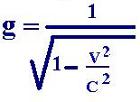
1. Time Dilation
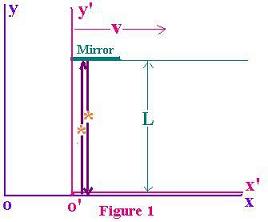
Let's consider the figure 1. The reference frame xoy
is at rest. The reference frame x'o'y' is moving at
the speed v in the direction o towards o'. The frame x'oy'
carries a mirror at the distance L from the observer o'.
If the observer in the frame x'oy' send a flash in
the direction o'y', this flash will reach the mirror
and then reflect back to arrive to this observer in
the point o'. The time for this travel is :
t' = L/c + L/c = 2L/c (1)
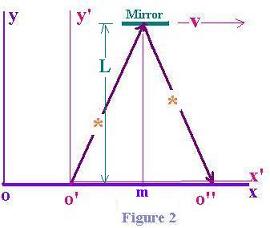
For the observer in the farme at rest xoy, the situation
is differente. It's related to the figure 2. When the
flash returned back to the observer o', the frame x'o'y'
(observer o' along with the mirror) were moved with the
speed v. The observer o' moved from o to o'. At this precise
position o', this observer o' receives the emitted flash
sent the time t before.
The flash has travelled ct/2 ( from o to Mirror) + ct/2 (from
Mirror to the o') =ct.
We can write:
(ct/2)2 = (o'm)2 + L2 (2)
o'm = vt/2,
L = ct'/2, from the equation (1)
Thus:
(ct/2)2 = (vt/2)2 + (ct'/2)2
Resolving for t', we get:
(ct'/2)2 = (ct/2)2 - (vt/2)2
t' 2 = (2/c) 2 (t/2)2 ( c2 -(v)2)
t' 2 = (t)2 ( 1 - (v)2/(c)2)
t' 2 = (t)2 ( 1/ g 2)
t' = t/g
or
t = gt' (3)

The factor g is greater than 1. Then t is greater that t'.
For the observer at rest, the time is longer than the time
in the moving frame is.
2. Length Contraction:
Now, let's consider the mirror attached in o'x' axis as
chown in figure 3. For the the moving observer in its
moving frame x'o'x', if a flash is sent from o', it will
reach Mirror and reflect back with the time t' = 2L'/c. (4)
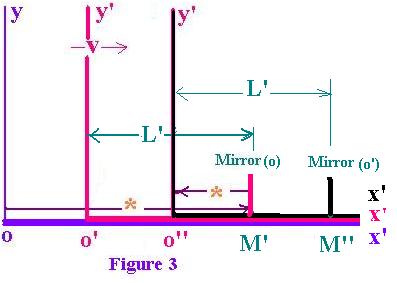
For the stationary observer, the situation is differente:
When the flash leaves from o' and reached Mirror, at
this precise time, the observer o' has moved to o' .
(supposed o=o' at first).
We have oo' = vt1 and oMirror = ct1
t1 is the time taken by the flash to go
from o to Mirror at the position M'.
We can write:
ct1 = oo' + L
( L is the distance between o' and Mirror for the observer in
the stationary xoy frame)
Thus:
ct 1= vt1 + L (5)
The flash reflects back and reaches the observer o' at
the position o'' while the observer o' has moved
from o' to o'' (The Mirror from M' to M'')
the related time to reflect back to the observer to o'
is t2.
We can write ct2 = L - v t2 (6)
The total time taken by the flash for its round trip is
t= t1 + t2
from (5) and from (6):
t = (L/ (c-v) + L/(c+v) = 2Lc/ c2 - v2
t = g2. 2L/c (7)
Solving for L', we have:
from (4) and from (3):
L' = ct'/2 = (c/2)(t/g)
And from (7)
L' = g L (8)
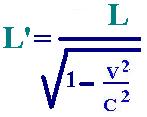
The factor g is greater than 1. Then L is smaller that L'.
For the observer at rest, the length is shorter than the length
in the moving frame is.
3. Lorentz Transformations
Now, for the observer in its farme xo'y', o'M' = o"M'". Let's write
it equal to x'.
At t'0, the flash leaves o' and at t' it
reaches the point x'.
Thus, for the moving observer,
c( t' - t'0) = L' = x' (9)
For the observer at rest, we have:
oM' = x
and c(t - t0) = oo' + L
= v. (t - t0) + L
Then :
(t - t0) = L/(c-v) (10)
Let's consider :
At x = 0, t0= 0.
Then ct = x ,
that is:
x = vt +L (11)
Solving for L :
L = x-vt (12)
Using the relation (8) : L' = gL
(12) becomes:
L' = g(x-vt)
or x' = g(x-vt) (13)
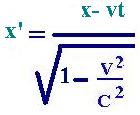
(9) gives:
t' = x'/c + t'0
Using (13) :
t' = g(x-vt)/c + t'0
Using the dilatation formula ( relation(3)):
t 0= gt'0
We have then:
t' = g(x-vt)/c + t0/g
Using the contraction formula ( relation(8)):
t 0 = t - L/(c-v) = t - (x-vt)/(c-v)
Thus:
t' = g(x-vt)/c + t/g - (x-vt)/(c-v)/g = g(x-vt)/c + (ct -x)/(c-v)g
= g( (x-vt)/c) + (ct-x)/(c-v).g2 )
= g( (x-vt)/c) +(ct-x)(c+v)/c2)
= g/c2(c2t -xv)
= g(t -xv/c2)
t' = = g(t -xv/c2) (14)
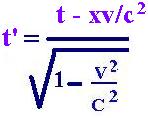
Since there is no change with y ans z
axis, we have y = y' and z= z'
When a reference frame (x'y'z't') moves at a speed v relating
to the reference frame at rest (xyzt), the relationships between
these coordinates are known as the Lorentz transformations
and grouped as fellow:
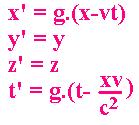
Remark:
In the case of very low velocities, g is near to 1, furthermore,
the Lorentz transformations become Galileo transformations.
4. Lorentz Inverse Transformations
The transformations above are set by the stationary observer
for whom the farme x'o'y' is moving at the speed +v.
The inverse transormation are obtained when the observers
change the roles. That is, for the observer in x'o'y', we
have the same transformations related to the frame xoy moving
at the speed -v:(changing prime in no prime and vis versa , -
in +). We have:
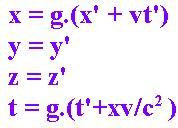
5. Lorentz Velocities Transformations
We are interested now to set the transformations of the components
of a certain vector velocity V ( Vx, Vy, Vz) related to V' ( V'x, V'y, V'z) .
From the relations above, we have the following differentiations:
dx = g(dx' + vdt'`)
dt = g(dt' + dx'v/c2)
dx/dt = Vx, the component of the velocity over ox.
Vx = (V'x + v)/(1 + V'x.v/c2)
Where V'x = dx'/dt' is the component of the velocity V' over o'x',
and v is the relative velocity of the frame
Vy = dy/dt = dy'/dt' = dy'/g(dt' + dx'v/c2)
= V'y/g(1 + dx'v/c2/dt')
= V'y/g(1 + V'x v/c2)
Vz = V'z/g(1 + V'x v/c2)
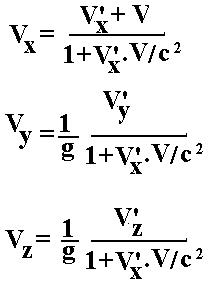
Remark that, it the moving observer in (x',y',z') referencial
frame meseares the velocity of light in this frame and finds
V'x = c , the first relation gives also Vx = c.
The conclusion is the speed of light is the same in these two
referential frames.
|

